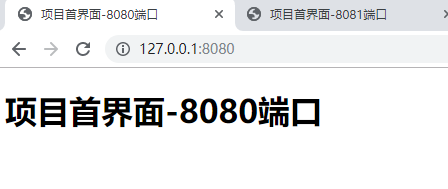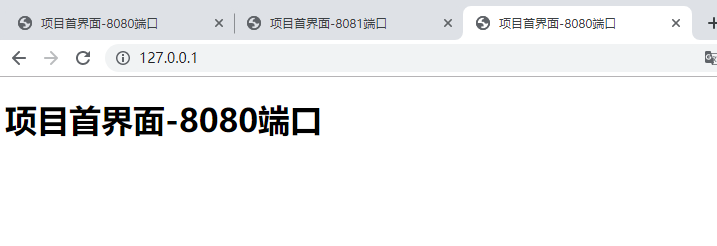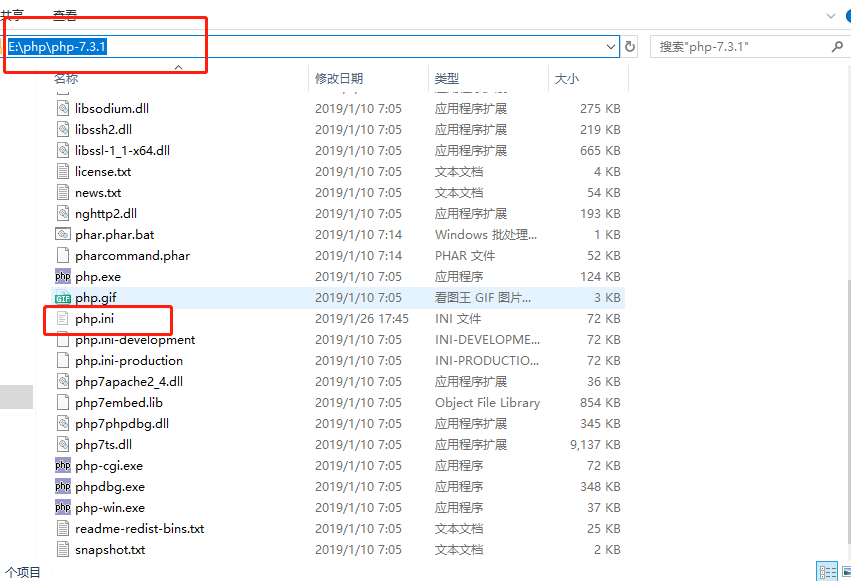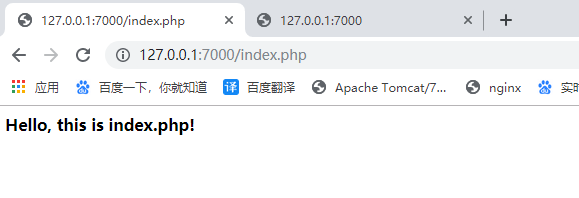nginx配置、proxy_passfast 和 cgi_pass区别,反向代理,负载均衡、nginx+fastcgi+php的并发阻塞问题
目录
1、准备两个tomcat和一个nginx
1.1、tomcat: http://127.0.0.1:8080
1.2、tomcat:http://127.0.0.1:8081
1.3、nginx:http://127.0.0.1
2、反向代理proxy_pass
2.1、反向代理
2.2、反向代理-使用upstream
2.3、反向代理-负载均衡-轮循模式
2.4、反向代理-负载均衡-权重模式
2.4、反向代理-负载均衡-ip_hash方式
3、网关代理fastcgi_pass(php+nginx配合)
3.1、php安装(本人安装的是php-7.3.1)
3.1.1、php下载
3.1.2、php配置
3.2、开启cgi端口
3.3、fastcgi_passnginx配置
3.3.1、新建文件夹:E:\php\www 。然后创建两个文件
3.3.2、创建文件index.php
3.3.3、创建文件index.html
3.3.4、修改nginx配置
3.4、调试页面截图
3.5、解决 nginx+fastcgi+php的并发阻塞问题
3.5.1、启动多个cgi端口(9000,9001端口)
3.5.2、nginx配置
3.5.3、测试
1、准备两个tomcat和一个nginx


官方文档;http://nginx.org/en/docs/http/ngx_http_proxy_module.html#proxy_pass
2.1、反向代理介绍:127.0.0.1的80端口转发到127.0.0.1:8080. 。在这里127.0.0.1就类似于服务器的ip地址同理。
server {
listen 80;
server_name localhost www.xxx.com; #域名
location / {
proxy_pass http://127.0.0.1:8080;
client_max_body_size 1024m; #请求体大小设置
}
}
效果展示

2.2、反向代理-使用upstream
upstream tomcat{
server 127.0.0.1:8081;
}
server {
listen 80;
server_name localhost www.xxx.com; #域名
location / {
proxy_pass http://tomcat;
client_max_body_size 1024m; #请求体大小设置
}
}

2.3、反向代理-负载均衡-轮循模式
轮询方式是默认方式,每个请求按照时间顺序逐一分配到不同的后端服务器进行处理,如有服务器宕机会被自动剔除。
# 负载均衡-轮循模式
upstream tomcat{
server 127.0.0.1:8080;
server 127.0.0.1:8081;
}
server {
listen 80;
server_name localhost www.xxx.com; #域名
location / {
proxy_pass http://tomcat;
client_max_body_size 1024m; #请求体大小设置
}
}
访问的时候刷新,会发现每次都不一样。为轮循
2.4、反向代理-负载均衡-权重模式
权重方式是利用weight指定的权重比率,与访问率成正比。用于后端服务器性能不均的情况。
# weigth参数表示权值,权值越高则被分配到的概率越大。测试的时候发现weight=3,刷新的时候8080端口就刷出3次
# max_fails允许请求失败的次数默认为l
# fail_timeoutq请求失败后暂停服务的时间
# backup预留的备份机器
# down表示当前的server暂时不参与负载均衡。
# weigth参数表示权值,权值越高则被分配到的概率越大。测试的时候发现weight=3,刷新的时候8080端口就刷出3次
# max_fails允许请求失败的次数默认为l
# fail_timeoutq请求失败后暂停服务的时间
# backup预留的备份机器
# down表示当前的server暂时不参与负载均衡。
upstream tomcat{
#weigrt权重值(越大访问率大),在fail_timeout时间内检查后端服务器max_fails次,失败则被剔除;
server 127.0.0.1:8080 weight=3 fail_timeout=30s max_fails=2;
server 127.0.0.1:8081 weight=1 fail_timeout=30s max_fails=2;
}
server {
listen 80;
server_name localhost www.xxx.com; #域名
location / {
proxy_pass http://tomcat;
client_max_body_size 1024m; #请求体大小设置
}
}
2.4、反向代理-负载均衡-ip_hash方式
ip_hash方式是按每个请求访问IP的hash结果分配,可以使每个访客固定访问一个后端服务器,可以解决Session共享的问题。
一般情况下不太建议使用这种方式
# ip_hash;
upstream tomcat{
ip_hash;
server 127.0.0.1:8080 fail_timeout=5s ;
server 127.0.0.1:8081 fail_timeout=5s ;
}
server {
listen 80;
server_name localhost www.xxx.com; #域名
location / {
proxy_pass http://tomcat;
client_max_body_size 1024m; #请求体大小设置
}
}
3、网关代理fastcgi_pass(php+nginx配合)
官方文档: http://nginx.org/en/docs/http/ngx_http_fastcgi_module.html#fastcgi_pass
fastcgi介绍:CGI全称是“公共网关接口”(Common Gateway Interface),HTTP服务器与你的或其它机器上的程序进行“交谈”的一种工具,其程序一般运行在网络服务器上。 CGI可以用任何一种语言编写,只要这种语言具有标准输入、输出和环境变量。如php,perl,tcl等。
这种模式一般和php配合一起使用所以我们首先要安装php
3.1、php安装(本人安装的是php-7.3.1)
3.1.1、php下载
进入PHP下载地址http://windows.php.net/download下载最新线程安全版PHP zip压缩包,解压缩后放在想要安装的路径下。注意:下载的PHP VC版本不能比前面安装的vc redist版高。
3.1.2、php配置
进入PHP安装目录,复制一份php.ini-development改名为php.ini放到安装路径下,打开找到"extension_dir",去掉注释符,将值改为"PHP安装路径\ext"。我当前的是:extension_dir = "E:\php\php-7.3.1\ext"
如图:

3.2、开启cgi端口
// 命令,在控制台执行
E:\php\php-7.3.1\php-cgi.exe -b 127.0.0.1:9000 -c E:\php\php-7.3.1\php.ini
如图:

3.3、fastcgi_passnginx配置
3.3.1、新建文件夹:E:\php\www 。然后创建两个文件

3.3.2、创建文件index.php
<?php
echo 'Hello, this is index.php!';
?>
3.3.3、创建文件index.html
this is index html
3.3.4、修改nginx配置
server {
listen 7000;
server_name localhost;
location / {
## 解决跨域的代码
add_header Access-Control-Allow-Origin *;
add_header Access-Control-Allow-Headers X-Requested-With;
add_header Access-Control-Allow-Methods GET,POST,PUT,DELETE,OPTIONS;
#创建的包含 index.html和 index.php的文件夹
root E:/php/www;
index index.html index.htm index.php;
try_files $uri $uri/ /index.php?$query_string;
}
# 判断后缀为php的地址
location ~ \.php$ {
#创建的包含 index.html和 index.php的文件夹
root E:/php/www;
fastcgi_pass 127.0.0.1:9000; #端口是上面开通的cgi端口
fastcgi_index index.php;
fastcgi_param SCRIPT_FILENAME $document_root$fastcgi_script_name;
include fastcgi_params;
}
error_page 500 502 503 504 /50x.html;
}
重启nginx:nginx.exe -s reload
3.4、调试页面截图
访问:http://127.0.0.1:7000/

访问:http://127.0.0.1:7000/index.php

3.5、解决 nginx+fastcgi+php的并发阻塞问题
3.5.1、启动多个cgi端口(9000,9001端口)
命令:E:\php\php-7.3.1\php-cgi.exe -b 127.0.0.1:9000 -c E:\php\php-7.3.1\php.ini

3.5.2、nginx配置
然后重启nginx:E:\php\nginx-1.18.0> nginx.exe -s reload
upstream fastcgi_proxy{
server 127.0.0.1:9000;
server 127.0.0.1:9001;
}
server {
listen 7000;
server_name localhost;
location / {
add_header Access-Control-Allow-Origin *;
add_header Access-Control-Allow-Headers X-Requested-With;
add_header Access-Control-Allow-Methods GET,POST,PUT,DELETE,OPTIONS;
root E:/php/www;
index index.html index.htm index.php;
try_files $uri $uri/ /index.php?$query_string;
}
location ~ \.php$ {
root E:/php/www;
fastcgi_pass fastcgi_proxy;
fastcgi_index index.php;
fastcgi_param SCRIPT_FILENAME $document_root$fastcgi_script_name;
include fastcgi_params;
client_max_body_size 10m;
}
error_page 500 502 503 504 /50x.html;
}
3.5.3、测试
经过测试发现,9000端口和9001端口只要有一个还在启动,http://127.0.0.1:7000/index.php 这个地址就可以访问
如由于需要相关软件和资料,欢迎留言
 xixiyuguang
xixiyuguang
 原创文章 54获赞 10访问量 7338
关注
私信
展开阅读全文
原创文章 54获赞 10访问量 7338
关注
私信
展开阅读全文
作者:xixiyuguang